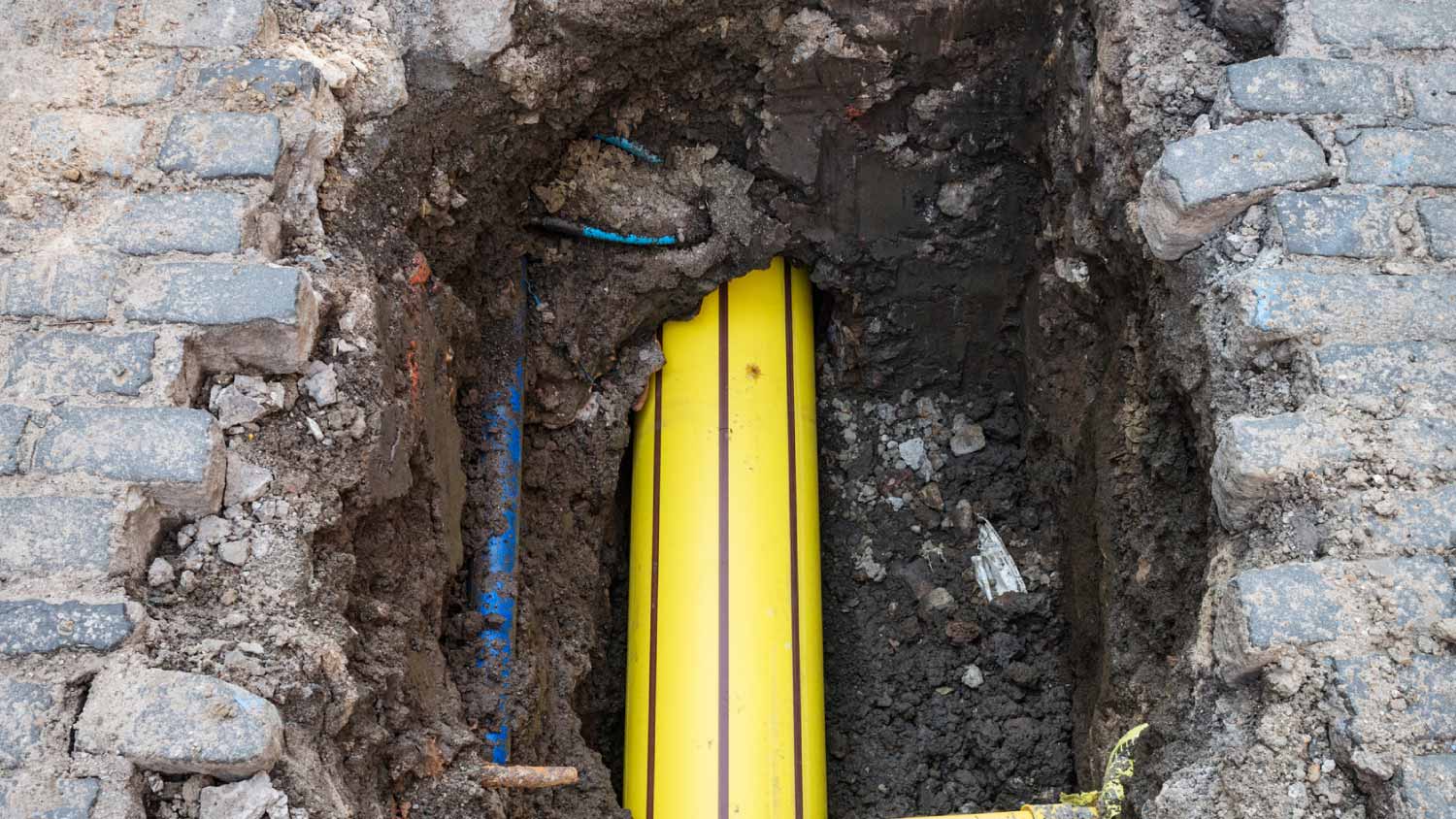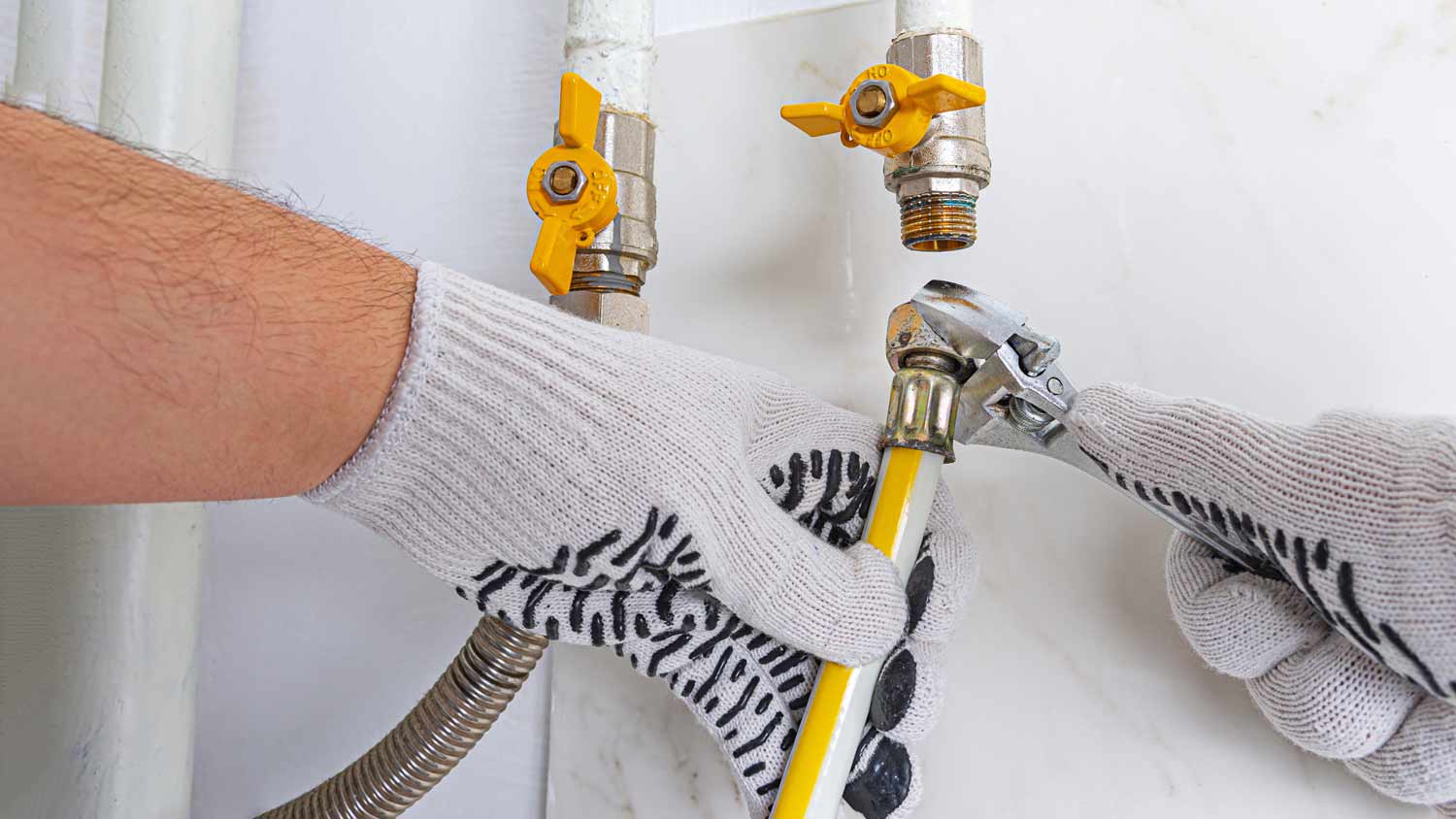
Find costs to repair a gas line and plan your budget based on the problem, from excavating for a new line to making a minor repair to an existing one.
If properly installed, your chance of a fire from CSST is as rare as a lightning strike


Flexible gas lines are made from corrugated stainless steel tubing (CSST)—a bendy, yellow-jacketed option that replaces black steel piping.
Risks related to lightning strikes and house fires are low when CSST is installed properly.
CSST resists damage and leaks, is durable, and is easy to expand to new appliances or spaces.
Alternative options include traditional black iron, polyethylene, and rigid stainless steel piping, which all have pros and cons of their own.
Always hire a licensed pro to inspect, install, repair, and replace gas lines.
Many homeowners scratch their heads when they see bending yellow gas lines in their homes instead of the traditional black steel pipes. If your house was built in the United States between the early ’90s and mid-2000s, you likely have natural gas piping made from corrugated stainless steel tubing—a popular, flexible replacement for black steel pipes. While flexible gas lines are safe if properly installed and less likely to leak gas, corrugated stainless steel tubing can lead to major house fires if struck by lightning.
If you’re wondering what the hype is with flexible gas lines, let’s clear some things up. Flexible gas lines are made from corrugated stainless steel tubing (CSST). These extremely flexible pipes are made from stainless steel and often come coated in a trademark yellow casing, though they can be black. This clever revamp of the traditional black steel pipes allows natural gas to travel to your fireplace, furnace, stovetop, and any other appliances that use natural gas.
In short, flexible gas lines are perfectly safe as long as they’re properly installed. A CSST gas line that is not correctly grounded or bonded can leak natural gas or become ignited, leading to a major fire hazard.
Let’s look at exactly why that happens: CSST is extremely thin compared to the traditional 4-mm black pipe. At about 0.2 mm, or the thickness of two sheets of paper, the odds of lightning surging through improperly grounded and bonded CSST rise. If this happens, the electricity from the lightning can arc, puncture a hole in the line, ignite the gas inside, and cause a fire.
You need a professional for this job, and they don’t come cheap.
When it comes to house fires, you shouldn’t worry—obsessively at least—about your CSST. According to the U.S. Fire Administration, cooking is by far the number one cause of house fires nationwide, making up 51% of residential fires. Lightning strikes are much rarer, accounting for only a portion of the 1.8% of residential fires caused by natural disasters. Those odds are even lower if you look at how many lightning strikes lead to fires via CSST.
That said, when CSST pipes burst, the pipe turns into a potential giant lightning rod. If the CSST isn’t properly bonded electrically, this can lead to a disaster.
It’s important that you have your home inspected by a local pro, especially if you aren’t sure about the status of your gas lines.

Speaking of the status of your gas lines, knowing which kind you have is key to determining whether or not your home is at risk of a gas line fire or leak.
To see if you have CSST, look for long stretches of yellow-jacketed, flexible tubing in your basement, crawlspace, or attic. The short flexible connector to your gas-fired stove, furnace, or hot water heater is not CSST.
Flexible gas lines bring many benefits compared to their traditional counterparts. Consider the following advantages to determine whether they’re right for your home.
Improved safety: Flexible gas lines are more resistant to damage and leaks than traditional gas lines, making them a safer alternative in many ways.
Durable: These gas lines are also quite durable and able to withstand many environmental conditions and temperatures.
Installation ease: Since flexible gas lines have fewer fittings and connections, they’re easier and less expensive to install than other types.
Versatility: The flexibility of these gas lines allows them to work for many different applications, ranging from connecting fixtures and appliances to reaching through tight and challenging spaces. CSST also comes in a variety of diameters, so your plumber should be able to find the right home gas pipe size for your needs.
Expansion ease: Most flexible gas lines use a multiport manifold system that allows for easy expansion should you add new appliances or rooms to your home.
Reduced leak risk: Flexible gas lines have fewer joints and connections than other types, thanks to their flexibility, which reduces the risk of gas leaks.
Lower maintenance: Unlike many of their traditional counterparts, flexible gas lines don’t require chemical injections to prevent corrosion, making them a lower-maintenance option.
Flexible gas lines are convenient, affordable, and durable, but they’re not your only option. Some homeowners and contractors still prefer more traditional types of gas pipes. If you’re looking for alternatives to flexible gas lines, here are a few options worth considering:
Black iron pipe: This type of gas pipe has been the go-to for decades. It’s tough, doesn’t flex, and can last longer than flexible options. A pro must carefully measure, cut, and thread the pipes and seal each joint for leak-proof installation.
Polyethylene (PE) pipe: PE piping is equal parts flexible and sturdy, and it’s easy to install in homes or underground. However, underground installations need careful placement or rocky or abrasive soil can damage the pipes. PE pipes are recyclable and the joints are easy to fuse with heat or mechanical fittings.
Rigid stainless steel pipe: Rigid stainless steel gas pipes are easy to install and don’t require threading. They’re pricier than black iron, but they resist rust and corrosion and hold up well over time.
Flexible stainless steel piping: This is a hybrid solution for homeowners who want some flexibility without the safety concerns of CSST gas lines. Flexible stainless steel piping is designed to be more resistant to lightning-related damage than CSST.
Soft copper tubing: Rigid copper pipes have become less popular and may not meet code in some areas, but soft copper is still used. It bends easily, so it doesn’t require multiple fittings. While it’s a good option for propane systems, natural gas can degrade it. If you are considering this option, talk to a gas plumber or local gas appliance repair service to make sure it fits your job.
The cost to replace flexible gas lines usually falls between $2 and $4 per linear foot. Correcting an existing installation can cost as little as $100, while replacing CSST with black pipe can cost several thousands of dollars. Expect to pay around $250 to correct the existing CSST and about $4,000 to replace it.
To get a quote, contact a local home inspector or licensed electrician near you to inspect your gas lines. Tell them you think you have CSST gas lines and want to make sure they’ve been properly grounded.
Keep in mind running, installing, or repairing a gas line often involves two different fields of expertise. You may very well need to hire a natural gas plumber in your area to install the actual gas line and hire an electrician to handle the electrical circuit if any repairs are necessary.
If you want to pay the most exorbitant prices possible for your job, this is the company for you. “By the job” pricing is a rip-off, at least how these people use it. Every job is plugged into a category and prices are set by category. You might have a job that takes half an hour or one that...
After hearing the panic in my voice (true) regarding a new leak, the owner came out himself the same day. Willing to explain all work, notified me of changes as he went and looked at a few extra items for opinion. Would absolutely recommend.
Called to say he was running early, and we agreed on a new, earlier time. Showed him the leaks we had, and said we wanted an estimate for both repair and replacement. He said he would send us a quote, and, he went outside to check the roof and never returned. We expected him to come in and...
Very well repaired quickly!
The service and quality was great. Doug went above and beyond and made other small repairs needed while he was on the job. Very trustworthy and friendly!
Rod was great. He repaired the dry wall in my utility closet so well you can't even tell there were holes there! I would highly recommend them.
Great!, Was able to get them to show up within 2 hours of calling, which was very much needed. Had a new refrigerator delivered that could not be installed. The main water shut off to my house and the shut off to the old refrigerator could not be turned off. Water was leaking everywhere...
The exhaust vent pipe to vent the furnace gas outside deteriorated and fell off. All knight replaced a "wye" connection and rehung the pipe. They were very responsive and met my schedule, and they were very mindful of my work/time commitments. The tech needed to run to the supplier to get the...
The service was very through and appeared to be very good. He did some things that repair people had never done before and patched leaks.
From average costs to expert advice, get all the answers you need to get your job done.

Find costs to repair a gas line and plan your budget based on the problem, from excavating for a new line to making a minor repair to an existing one.

Whether it's time for pipe replacement or to hook up the range of your dreams, gas line installation cost is an important line in your budget. Let's take a look.

Understanding the signs of a gas leak in your house can keep your family safe. Know what to look out for and what to do if you suspect signs of a gas leak.

Moving or installing gas piping involves careful planning and execution. Review these gas pipe questions to ensure you’re ready for a conversation with a pro.

Gas fitters and plumbers are both qualified to work on natural gas lines, but what you call them depends on where you live.
Is a homeowner liable if a contractor hits a gas line while digging? Not if you or your contractor have the gas line marked before digging.